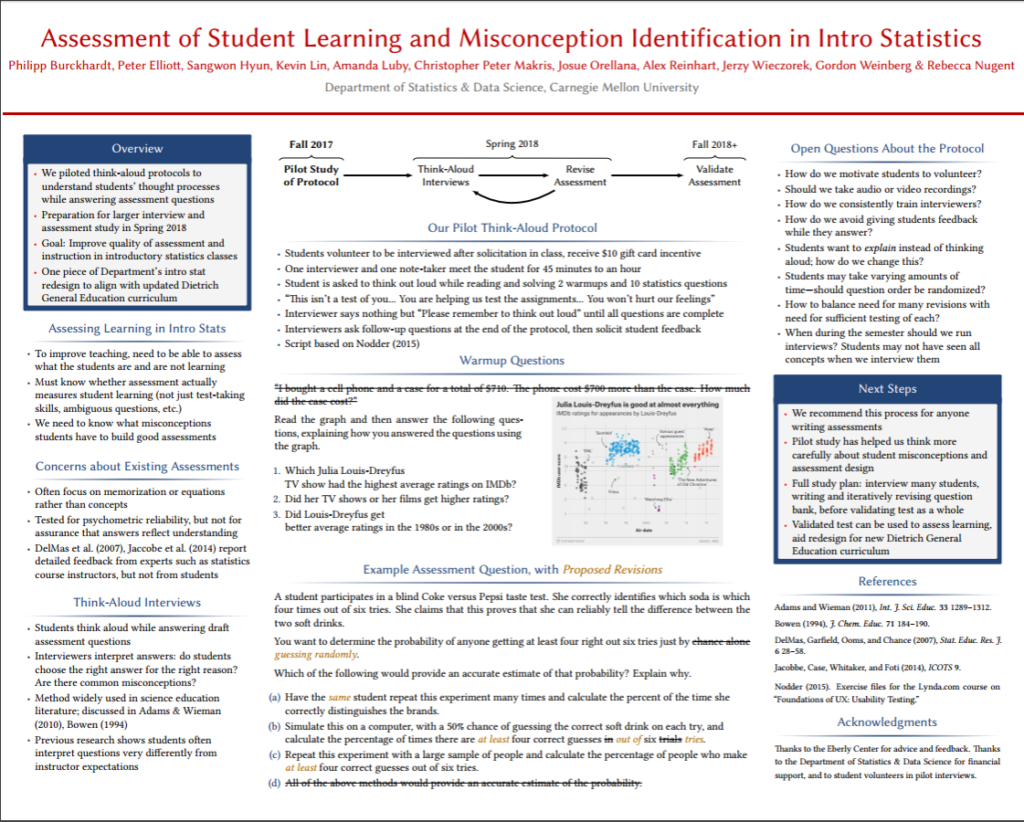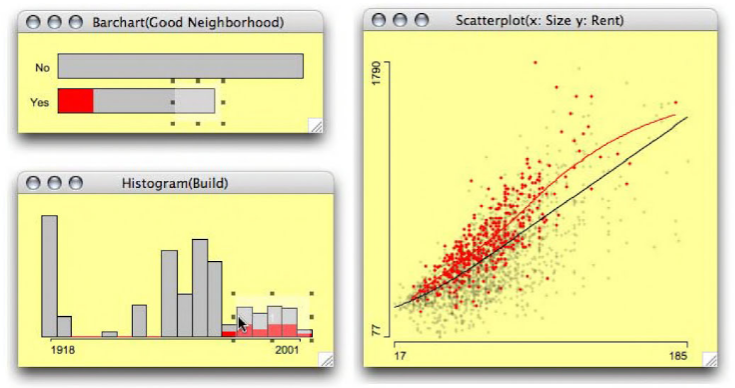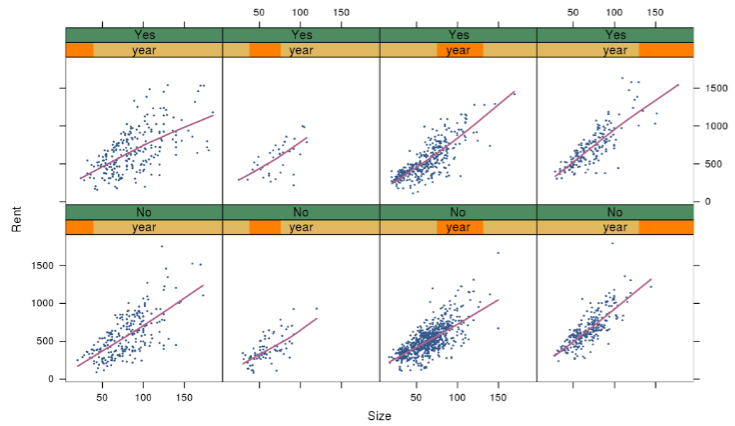Posting far too late again, but here’s what I remember from last Spring…
This was my first semester with no teaching, TAing, or classes (besides one I audited for fun). As much as I enjoy these things, research has finally gone much faster and smoother with no other school obligations. The fact that our baby started daycare also helped, although it’s a bittersweet transition. At the end of the summer I passed my proposal presentation, which means I am now ABD!
Previous posts: the 1st, 2nd, 3rd, 4th, and 5th semesters of my Statistics PhD program.
Thesis research and proposal
During 2015, most of my research with my advisor, Jing Lei, was a slow churn through understanding and extending his sparse PCA work with Vince Vu. At the end of the year I hadn’t gotten far and we decided to switch to a new project… which eventually became my proposal, in a roundabout way.
We’d heard about the concept of submodularity, which seems better known in CS, and wondered where it could be useful in Statistics as well. Das & Kempe (2011) used submodularity to understand when greedy variable selection algorithms like Forward Selection (FS, aka Forward Stepwise regression) can’t do too much worse than Best Subsets regression. We thought this approach might give a new proof of model-selection consistency for FS. It turned out that submodularity didn’t give us a fruitful proof approach after all… but also that (high-dimensional) conditions for model-selection consistency of FS hadn’t been derived yet. Hence, this became our goal: Find sufficient conditions for FS to choose the “right” linear regression model (when such a thing exists), with probability going to 1 as the numbers of observations and variables go to infinity. Then, compare these conditions to those known for other methods, such as Orthogonal Matching Pursuit (OMP) or the Lasso. Finally, analyze data-driven stopping rules for FS—so far we have focused on variants of cross-validation (CV), which is surprisingly not as well-understood as I thought.
One thing I hadn’t realized before: when writing the actual proposal, the intent is to demonstrate your abilities and preparedness for research, not necessarily to plan out your next research questions. As it turns out, it’s more important to prove that you can ask interesting questions and follow through on them. Proposing concrete “future work” is less critical, since we all know it’ll likely change by the time you finish the current task. Also, the process of rewriting everything for the paper and talk was a helpful process itself in getting me to see the “big picture” ideas in my proofs.
Anyhow, it did feel pretty great to actually complete a proof or two for the proposal. Even if the core ideas really came from my advisor or other papers I’ve read, I did do real work to pull it all together and prepare the paper & talk.
Many thanks to everyone who attended my proposal talk. I appreciated the helpful questions and discussion; it didn’t feel like a grilling for its own sake (as every grad student fears). Now it’s time to follow through, complete the research, practice the paper-submission process, and write a thesis!
The research process
When we shifted gears to something my advisor does not already know much about, it helped me feel much more in charge and productive. Of course, he caught up and passed me quickly, but that’s only to be expected of someone who also just won a prestigious NSF CAREER award.
Other things that have helped: Getting the baby into day care. No TAing duties to divide my energy this semester. Writing up the week’s research notes for my advisor before each meeting, so that (1) the meetings are more focused & productive and (2) I build up a record of notes that we can copy-paste into papers later. Reading Cal Newport’s Deep Work book and following common-sense suggestions about keeping a better schedule and tracking better metrics. (I used to tally all my daily/weekly stats-related work hours; now I just tally thesis hours and try to hit a good target each week on those alone, undiluted by side stuff.)
I’m no smarter, but my work is much more productive, I feel much better, and I’m learning much more. Every month I look back and realize that, just a month ago, I’d have been unable to understand the work I’m doing today. So it is possible to learn and progress quite quickly, which makes me feel much better about this whole theory-research world. I just need to immerse myself, spend enough time, revisit it regularly enough, have a concrete research question that I’m asking—and then I’ll learn it and retain it far better than I did the HWs from classes I took.
Indeed, a friend asked what I’d do differently if I were starting the PhD again. I’d spend far less energy on classes, especially on homework. It feels good and productive to do HW, and being good at HW is how I got here… but it’s not really the same as making research progress. Besides, as interesting and valuable as the coursework has been, very little of it has been directly relevant to my thesis (and the few parts that were, I’ve had to relearn anyway). So I’d aim explicitly for “B equals PhD” and instead spend more time doing real research projects, wrapping them up into publications (at least conference papers). As it is, I have a pile of half-arsed never-finished class / side projects, which could instead be nice CV entries if I’d polished them instead of spending hours trying to get from a B to an A.
My advisor also pointed out that he didn’t pick up his immense store of knowledge in a class, but by reading many many papers and talking with senior colleagues. I’ve also noticed a pattern from reading a ton of papers on each of several specialized sub-topics. First new paper I encounter in an area: whoa, how’d they come up with this from scratch, what does it all mean? Next 2-3 papers: whoa, these all look so different, how will I ever follow the big ideas? Another 10-15 papers: aha, they’re actually rehashing similar ideas and reusing similar proof techniques with small variations, and I can do this too. Reassuring, but it does all take time to digest.
All that said, I still feel like a slowly-plodding turtle compared to the superstar researchers here at CMU. Sometimes it helps to follow Wondermark’s advice on how he avoided discouragement in webcomics: ignore the more-successful people already out there and make one thing at a time, for a long time, until you’ve made many things and some are even good.
(Two years in!) I had just learned the word “webcomics” from a panel at Comic-Con. I was just starting to meet other people who were doing what I was doing.
Let me repeat that: Two years and over a hundred strips in is when I learned there was a word for what I was doing.
I had a precious, lucky gift that I don’t know actually exists anymore: a lack of expectations for my own success. I didn’t know any (or very few) comic creators personally; I didn’t know their audience metrics or see how many Twitter followers they had or how much they made on Patreon. My comics weren’t being liked or retweeted (or not liked, or not retweeted) within minutes of being posted.
I had been able to just sit down and write a bunch of comics without anyone really paying attention, and I didn’t have much of a sense of impatience about it. That was a precious gift that allowed me to start finding my footing as a creator by the time anyone did notice me – when people did start to come to my site, there was already a lot of content there and some of it was pretty decent.
Such blissful ignorance is hard to achieve in a department full of high-achievers. I’ve found that stressing about the competition doesn’t help me work harder or faster. But when I cultivate patience, at least I’m able to continue (at my own pace) instead of stopping entirely.
[Update:] another take on this issue, from Jeff Leek:
Don’t compare myself to other scientists. It is very hard to get good evaluation in science and I’m extra bad at self-evaluation. Scientists are good in many different dimensions and so whenever I pick a one dimensional summary and compare myself to others there are always people who are “better” than me. I find I’m happier when I set internal, short term goals for myself and only compare myself to them.
Classes
I audited Christopher Phillips’ course Moneyball Nation. This was a gen-ed course in the best possible sense, getting students to think both like historians and like statisticians. We explored how statistical/quantitative thinking entered three broad fields: medicine, law, and sports.
Reading articles by doctors and clinical researchers, I got a context for how statistical evidence fits in with other kinds of evidence. Doctors (and patients!) find it much more satisfying to get a chemist’s explanation of how a drug “really works,” vs. a statistician’s indirect analysis showing that a drug outperforms placebo on average. Another paper confirmed for me that (traditional) Statistics’ biggest impact on science was better experimental design, not better data analysis. Most researchers don’t need to collaborate with a statistical theoretician to derive new estimators; they need an applied statistician who’ll ensure that their expensive experimental costs are well spent, avoiding confounding and low power and all the other issues.
[Update:] I’ve added a whole post on these medical articles.
In the law module, we saw how difficult it is to use statistical evidence appropriately in trials, and how lawyers don’t always find it to be useful. Of course we want our trial system to get the right answers as often as possible (free the innocent and catch the guilty), so from a purely stats view it’s a decision-theory question: what legal procedures will optimize your sensitivity and specificity? But the courts, especially trial by jury, also serve a distinct social purpose: ensuring that the legal decision reflects and represents community agreement, not just isolated experts who can’t be held accountable. When you admit complicated statistical arguments that juries cannot understand, the legal process becomes hard to distinguish from quack experts bamboozling the public, which undermines trust in the whole system. That is, you have the right to a fair trial by a jury of your peers; and you can’t trample on that right in order to “objectively” make fewer mistakes. (Of course, this is also an argument for better statistical education for the public, so that statistical evidence becomes less abstruse.)
[Update:] In a bit more detail, “juries should convict only when guilt is beyond reasonable doubt. …one function of the presumption of innocence is to encourage the community to treat a defendant’s acquittal as banishing all lingering suspicion that he might have been guilty.” So reasonable doubt is meant to be a fuzzy social construct that depends on your local community. If trials devolve into computing a fungible “probability of guilt,” you lose that specificity / dependence on local community, and no numerical threshold can truly serve this purpose of being “beyond a reasonable doubt.” For more details on this ritual/pageant view of jury trials, along with many other arguments against statistics in the courtroom, see (very long but worthwhile) Tribe (1971), “Trial by Mathematics: Precision and Ritual in the Legal Process” [journal, pdf].
[Note to self: link to some of the readings described above.]
Next time I teach I’ll also use Prof. Phillips’ trick for getting to know students: require everyone to sign up for a time slot to meet in his office, in small groups (2-4 people). This helps put names to faces and discover students’ interests.
Other projects
I almost had a Tweet cited in a paper 😛 Rob Kass sent along to the department an early draft of “Ten Simple Rules for Effective Statistical Practice” which cited one of my tweets. Alas, the tweet didn’t make it into the final version, but the paper is still worth a read.
I also attended the Tapestry conference in Colorado, presenting course materials from the Fall 2015 dataviz class that I taught. See my conference notes here and here.
Even beyond that, it’s been a semester full of thought on statistical education, starting with a special issue in The American Statistician (plus supplementary material). I also attended a few faculty meetings in our college of humanities and social sciences, to which our statistics department belongs. They are considering future curricular revisions to the general-education requirements. What should it mean to have a well-rounded education, in general and specifically at this college? These chats also touch on the role of our introductory statistics course: where should statistical thinking and statistical evidence fit into the training of humanities students? This summer we started an Intro Stats working group for revising our department’s first course; I hope to have more to report there eventually.
Finally, I TA’ed for our department’s summer undergraduate research experience program. More on that in a separate post.
Life
My son is coordinated enough to play with a shape-sorter, which is funny to watch. He gets so frustrated that the square peg won’t go in the triangular hole, and so incredibly pleased when I gently nudge him to try a different hole and it works. (Then I go to meet my advisor and it feels like the same scene, with me in my son’s role…)
He’s had many firsts this spring: start of day care, first road trip, first time attending a wedding, first ER visit… Scary, joyful, bittersweet, all mixed up. It’s also becoming easier to communicate, as he can understand us and express himself better; but he also now has preferences and insists on them, which is a new challenge!
I’ve also joined some classmates in a new book club. A few picks have become new favorites; others really put me outside my comfort zone in reading things I’d never choose otherwise.
Next up
The 7th, 8th, 9th, and 10th semesters of my Statistics PhD program.




